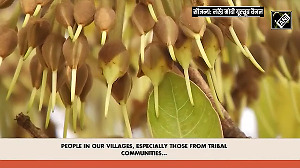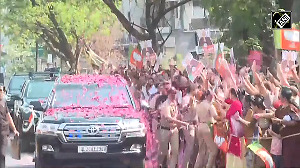The suite at New Delhi's Imperial Hotel is absurdly large. Vases full of white roses have been strategically put on table-tops across the room, and on one side a huge veranda lets in the autumn sunlight.
This is Vijay Shah's temporary abode for his stay in the capital. The Antwerp-based diamond giant, chairman of the $400 million Vijaydimon Group, is in town to launch Signet, his company's first retail store. They've decided to set up shop in the bustling South Extension market, which also houses shops like Mango, Tommy Hilfiger and Lacoste -- about the nearest thing to a branded high street that New Delhi has.
The suite is busy; it's Friday afternoon and the official launch (complete with a fashion show by Tarun Tahiliani) is to take place on Saturday night. A friend of Shah's, also a diamond merchant, is also present, and he's worried about the final lists for the party.
When he is assured that almost everyone has confirmed, he starts to reel off names of A-list Bollywood celebrities who have promised to show up. This is the second such launch in two weeks in the capital.
Last Saturday, the launch of the Mumbai-based DiA boutique, owned by Devaunshi Mehta, whose family have been DTC sightholders (under the company Mohanlal Raichand & Sons) for over half a century, attracted such celebrities as Jaya Bachchan, Tina Ambani and steel magnate L N Mittal.
After all this talk of parties and celebrity lists, Vijay Shah, when you meet him, is a surprise. He seems to be a quiet man, dragged against his will into the media spotlight.
And usually, the diamond trade would be the perfect place for a recluse -- historically, it has always been a place of shadowy exclusivity, dominated in production by the South African giant De Beers (although the power of De Beers is now on the decline) and manufacture by groups of Hasidic Jews and oddly enough, Palanpuri Jains.
It's only when you start to get into retail, as Shah is discovering, that you need to step out of the shadows. (The other time, incidentally, that Vijay Shah was conspicuously in the news was in 2002, when he held the double wedding of his son and daughter in an $18 million flight of fancy in Antwerp).
The rise of the Palanpuri Jains in international diamond trading is as surprising as it has been astronomical. It seems you cannot throw a stone in Antwerp (the diamond trading capital of the world) without hitting a Shah or a Mehta, and they're making their presence felt in hubs like Tel Aviv and New York as well.
No one knows what has made this particular community so successful (especially given that there has not been a comparable history of diamond production in Gujarat); and if Vijay Shah knows, he's not talking. "We have always been in this business," he says slowly.
"My father was a diamond merchant. When my brother (film producer Bharat Shah) and I got into the business, we had already learnt a lot from his example." But why Palanpuri Jains, I press.
"It's really nothing new. Indians have been successful in all kinds of areas." I persevere and finally he relents: it may be something to do with the strong work ethic of the community. This is one of many characteristics that Palanpuri Jains seem to have in common with Hasidic Jews -- others are a religious orthodoxy and deep family feeling, which keeps the respective communities very close-knit. Labour was also cheap in India when the trend of polishing and cutting diamonds started here.
Starting by squeezing profits from small diamonds that no one else wanted, factories in Gujarat (some figures say that 10 out of every 12 diamonds in the world are polished in Surat) grew to the point where they now handle approximately 80 per cent of diamonds globally.
The diamond export industry in India is said to be worth approximately $8 billion, and Indian diamond cutting and polishing firms now have offices all over the world.
Vijay Jain, CEO, Orra is slightly more forthcoming than Shah. Orra comes from Rosy Blue, one of the biggest diamond companies in the business, worth approximately $1.5 billion and present in 15 countries. "It is interesting that it's such a small community that is dominating the diamond industry," says Jain.
"Perhaps it's because you need a very high level of trust, and the value of the items is so high. This community is unique because it is able to work with each other, which is very important. Obviously, they don't discuss individual market details, but if it's something more general (like getting into retail), they will probably be able to share information."
There is much inter-marriage within the community as well, for instance, the daughters of Vijay Shah are married to various Mehtas; one from Gembel (also the family of Mohanlal Raichand and DiA), and two from Eurostar, and if this weren't enough, he is also related to the Mehtas of Rosy Blue.
The trend globally is pointing towards a movement away from cloak-and-dagger secrecy in the diamond industry. De Beers, from owning 80 per cent of the production of diamonds globally, has now reached a plateau of about 60 per cent, thanks to mines found in Russia and Australia, far from Africa and De Beers' control.
Outrage over "conflict diamonds" have called for greater transparency within the industry. It seems, though, that in the Indian community, the shroud of secrecy still hangs low. Industry insiders hint of the pressures of DTC to downstream into marketing and retailing, which may explain the sudden spurt of retail shops -- but there's no way of knowing for sure, because no one's talking.






 © 2025
© 2025